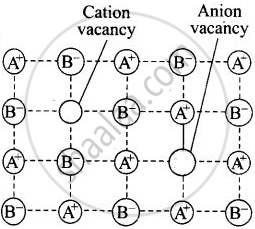Advertisements
Advertisements
Question
Schottky defect is observed in crystals when ______.
Options
some cations move from their lattice site to interstitial sites.
equal number of cations and anions are missing from the lattice.
some lattice sites are occupied by electrons.
some impurity is present in the lattice.
Solution
Schottky defect is observed in crystals when equal number of cations and anions are missing from the lattice.
Explanation:
| Defect | Definition | Type of solid |
Effect of defect on density of substance |
Structure of crystal (with defect) |
| Schottky defect |
A crystal is said to have Schottky defect if equal number of cations and anions are missing from their normal lattice site there by creating vacancies or holes. |
Ionic solid |
Decreases |  Schottky defect in a crystal |
APPEARS IN
RELATED QUESTIONS
What type of defect is shown by NaCl in
stoichiometric defects, and
Defects in solids can be studied using
Type of stoichiometric defect shown by ZnS is ____________.
Type of stoichiometric defect shown by AgBr is ____________.
Assertion: No compound has both Schottky and Frenkel defects.
Reason: Both defects change the density of the solid.
Assertion: Due to Frenkel defect, there is no effect on the density of the crystalline solid.
Reason: In Frenkel defect, no cation or anion leaves the crystal.
Silver halides generally show:
Which of the following point defects are shown by AgBr(s) crystals?
- Schottky defect
- Frenkel defect
- Metal excess defect
- Metal deficiency defect
Which of the following statements are not true?
(i) Vacancy defect results in a decrease in the density of the substance.
(ii) Interstitial defects results in an increase in the density of the substance.
(iii) Impurity defect has no effect on the density of the substance.
(iv) Frankel defect results in an increase in the density of the substance.
If NaCl is doped with 10–4 mole percent of SrCl2 the concentration of cation vacancies will be
